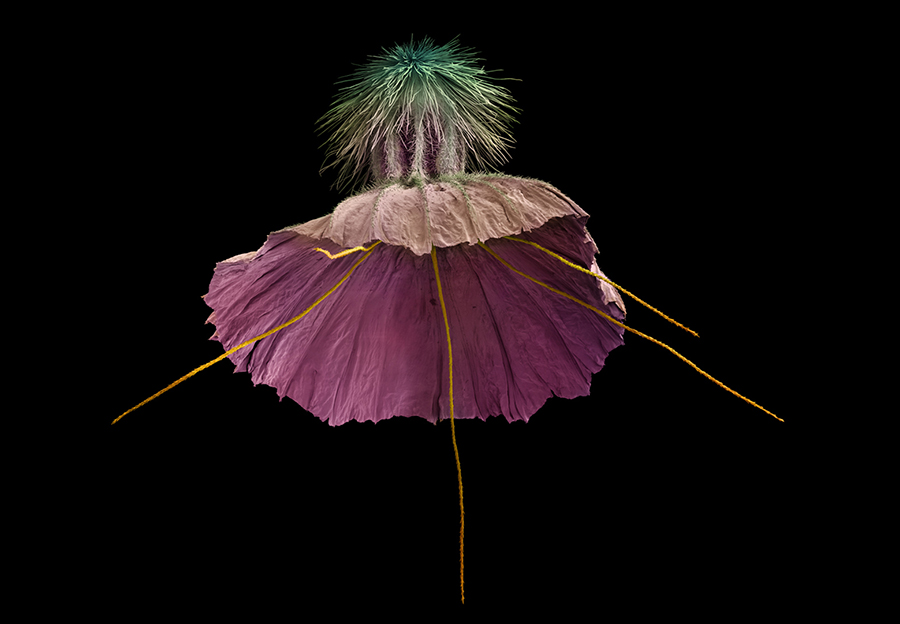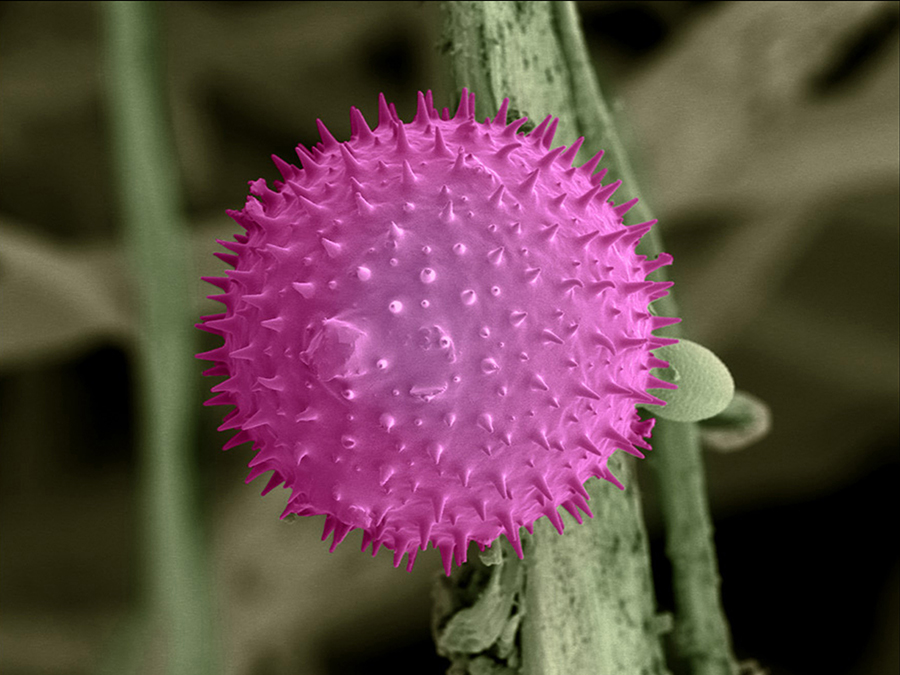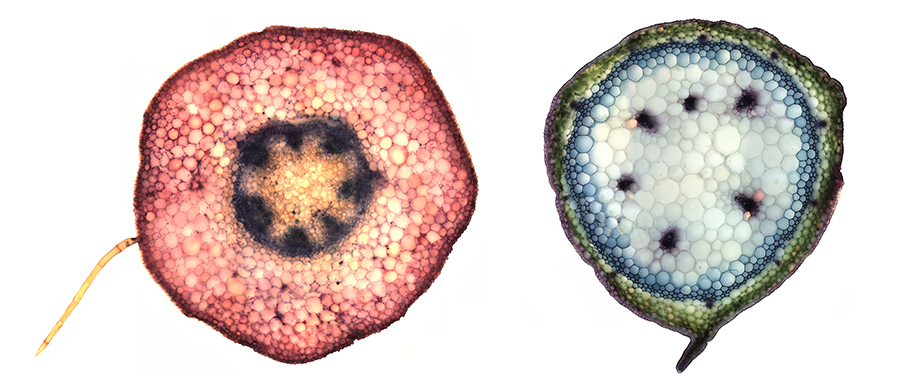Name: Rob Kesseler
Which came first in your life, the science or the art?
It’s a close run thing, I was born with a pencil and paintbrush in my hand and nature was my subject, so if the living world counts as science it was a dead heat. Looking back though, I was always going to be an artist and I experienced science more through the colourful and intriguing images and diagrams in my science books. When I was ten my father gave me a beautiful brass Victorian microscope. Given the inflexibility of the British education system at that time, I had to choose between art and biology. It wasn’t possible to study both and so I pitched for biology. After a year of dismal results I was switched to art and my future looked set.

Tweedia caerulea

Medicago minima | Medicago arborea
Which sciences relate to your art practice?
I think I have always been driven by the visualization of the living world and how it migrates into our daily lives through flowers, animals, and insects. Plant science and biology are the main draws for me. There is also something of the metamorphic, cyclical nature of the plant world that is a constantly rejuvenating process. At this time of year with each day signs of life are starting to emerge; catkins on woodland trees, spring bulbs popping up in the park and as the seasons unfold the whole cycle of life is played out before our eyes.

Scabiosa cretica

Ranunculus pygmaeus
What materials do you use to create your artworks?
Well, I guess the plants themselves are the starting material. As a physical subject, specimens need preparing for examination under the microscope. Stem sections are stained in special dyes to reveal their structures. Seeds and pollen are coated with a micro-fine layer of gold or platinum before being bombarded with a beam of electron particles in the scanning microscope. From there the black and white images that emerge from the microscope are cleaned up, assembled (sometimes up to 600 frames for a single image) and finally painstakingly hand coloured, building up and working through many subtle layers of chromatic variations. Just as the plant uses colour to attract an audience of insect collaborators for pollination, I use colour to attract a human audience by creating images that lie somewhere between science and symbolism. Whilst existing as images in their own right, I also use them in print form on other surface and objects, particularly ceramics and silk fabric. I also recently collaborated with the glassmaker Stewart Hearn to create a series of coloured lens forms based on my drawings of mammalian eggs prior to fertilization for an exhibition about mitosis.

Zona in Vitro
Artwork/Exhibition you are most proud of:
Gathered – an event I hosted in 2000. It was the culmination of a project with Grizedale Arts, and took the form of an al fresco banquet high up on the fells, close to Brantwood the former home of John Ruskin. The title of the work “Gathered” is taken from one of Ruskin’s manuscripts for Proserpina in which he describes the forms and habitats of local flowers. Words and fragments of texts from the manuscript appear with the pollen images on the dinner service. As flowers pressed in a book leave a faded stain, Ruskin’s words sink onto the surface of the glaze like inky ghosts. The banquet became a metaphor for cross-pollination, a fertile exchange between groups of people drawn together for one brief moment in time. A botanist, a poet, a herbalist, a beekeeper, a writer, in all twelve individuals each with their own special connection with the work, each with their own contribution to make. They were treated to a menu devised by the food writer Nichola Fletcher that drew upon local produce. Arctic Char from Lake Conniston, venison from Grizedale, wild mushrooms and forest fruits. It proved to the springboard that ignited my entry into the science world.

Gathered plate
Which scientists and/or artists inspire and/or have influenced you?
It is always difficult to pin it down to just a few names, but I would have to credit Madeline Harley at Kew as the first scientist who responded to my enquiries and opened the doors to her lab. Her generosity enabled me to work with her and produce our first book, Pollen: the hidden sexuality of flowers. Thirteen years later it is in its fourth edition and still growing strong. The other person would be Wolfgang Stuppy, the seed morphologist from the Millennium Seed Bank with whom I have worked closely for ten years on more books: Seeds: time capsules of life and Fruit: edible, inedible, incredible. The publisher and designer of the books Alexandra Papadakis was also hugely important and believed in our vision when larger more famous publishers didn’t see a market for them. I learned so much and am indebted to these three friends and I wouldn’t be able to do the work I do now without their inspirational support. I have enjoyed working too with Enrico Coen from the John Innes Centre in Norwich. His research into the morphology of flowers has led to some really exciting animations based on genetic data.

Malva pollen on car filter

Krameria seed
As for the artists, there are centuries of great botanical artists and illustrators I look at. Picking a few names out of the hat I might include: Albrecht Durer, Jacabo Ligozzi, Maria Sibylla Merian, Franz and Ferdinand Bauer, Ernst Haeckel, Karl Blossfeldt, the list is really endless. More recently I have enjoyed the work of the young Japanese artist Macoto Murayama who makes highly detailed, almost engineering-like, drawings and animations based on highly accurate dissections of flowers. Also, Sarah Craske, a recent graduate from the MA Art and Science course at Central Saint Martins, did a wonderful project on Biological Hermeneutics using a 17th Century edition of Ovid’s Metamorphoses in which she grew bacteria that had laid dormant on the pages for centuries.

Primula and Garlic | Stained sections
Is there anything else you want to tell us?
Throughout my life I have operated in a kind of twilight zone where art, design, and craft, overlap with a more recent addition of science. Not always the easiest career choice, but it has given me a wonderful perspective on the interconnectedness of things. There have been times in the past when the work of scientists has anticipated the future tropes of artists and vice versa. I like to think we are entering a new age where after a century of separation, artists and scientists are again working together, sharing ideas that reflect our age and despite the blinkered ignorance of some politicians, hopefully will drive us to a better place.

Macallan oak section
Links: Co Cultures, Papadakis, Instagram
Share this Post

